My solution, as used in one of my own projects, is posted beneath. Feel free to copy-and-paste, I intend to open-source this project once it's finished :)
A preview of the player can be seen on YouTube: http://www.youtube.com/watch?v=Q98DQ6iNTYM
AudioPlayer.h
@protocol AudioPlayerDelegate;
@interface AudioPlayer : NSObject
@property (nonatomic, assign, readonly) BOOL isPlaying;
@property (nonatomic, assign) id <AudioPlayerDelegate> delegate;
+ (AudioPlayer *)sharedAudioPlayer;
- (void)playAudioAtURL:(NSURL *)URL;
- (void)play;
- (void)pause;
@end
@protocol AudioPlayerDelegate <NSObject>
@optional
- (void)audioPlayerDidStartPlaying;
- (void)audioPlayerDidStartBuffering;
- (void)audioPlayerDidPause;
- (void)audioPlayerDidFinishPlaying;
@end
AudioPlayer.m
// import AVPlayer.h & AVPlayerItem.h
@interface AudioPlayer ()
- (void)playerItemDidFinishPlaying:(id)sender;
@end
@implementation AudioPlayer
{
AVPlayer *player;
}
@synthesize isPlaying, delegate;
+ (AudioPlayer *)sharedAudioPlayer
{
static dispatch_once_t pred;
static AudioPlayer *sharedAudioPlayer = nil;
dispatch_once(&pred, ^
{
sharedAudioPlayer = [[self alloc] init];
[[NSNotificationCenter defaultCenter] addObserver:sharedAudioPlayer selector:@selector(playerItemDidFinishPlaying:) name:AVPlayerItemDidPlayToEndTimeNotification object:nil];
});
return sharedAudioPlayer;
}
- (void)playAudioAtURL:(NSURL *)URL
{
if (player)
{
[player removeObserver:self forKeyPath:@"status"];
[player pause];
}
player = [AVPlayer playerWithURL:URL];
[player addObserver:self forKeyPath:@"status" options:0 context:nil];
if (delegate && [delegate respondsToSelector:@selector(audioPlayerDidStartBuffering)])
[delegate audioPlayerDidStartBuffering];
}
- (void)play
{
if (player)
{
[player play];
if (delegate && [delegate respondsToSelector:@selector(audioPlayerDidStartPlaying)])
[delegate audioPlayerDidStartPlaying];
}
}
- (void)pause
{
if (player)
{
[player pause];
if (delegate && [delegate respondsToSelector:@selector(audioPlayerDidPause)])
[delegate audioPlayerDidPause];
}
}
- (BOOL)isPlaying
{
DLog(@"%f", player.rate);
return (player.rate > 0);
}
#pragma mark - AV player
- (void)observeValueForKeyPath:(NSString *)keyPath ofObject:(id)object change:(NSDictionary *)change context:(void *)context
{
if (object == player && [keyPath isEqualToString:@"status"])
{
if (player.status == AVPlayerStatusReadyToPlay)
{
[self play];
}
}
}
#pragma mark - Private methods
- (void)playerItemDidFinishPlaying:(id)sender
{
DLog(@"%@", sender);
if (delegate && [delegate respondsToSelector:@selector(audioPlayerDidFinishPlaying)])
[delegate audioPlayerDidFinishPlaying];
}
@end
AudioPlayerViewController.h
extern NSString *const kAudioPlayerWillShowNotification;
extern NSString *const kAudioPlayerWillHideNotification;
@interface AudioPlayerViewController : UIViewController
@property (nonatomic, assign, readonly) BOOL isPlaying;
@property (nonatomic, assign, readonly) BOOL isPlayerVisible;
- (void)playAudioAtURL:(NSURL *)URL withTitle:(NSString *)title;
- (void)pause;
@end
AudioPlayerViewController.m
NSString *const kAudioPlayerWillShowNotification = @"kAudioPlayerWillShowNotification";
NSString *const kAudioPlayerWillHideNotification = @"kAudioPlayerWillHideNotification";
@interface AudioPlayerViewController () <AudioPlayerDelegate>
@property (nonatomic, strong) AudioPlayerView *playerView;
- (void)playButtonTouched:(id)sender;
- (void)closeButtonTouched:(id)sender;
- (void)hidePlayer;
@end
@implementation AudioPlayerViewController
@synthesize playerView, isPlaying, isPlayerVisible;
- (id)initWithNibName:(NSString *)nibNameOrNil bundle:(NSBundle *)nibBundleOrNil
{
self = [super initWithNibName:nibNameOrNil bundle:nibBundleOrNil];
if (self)
{
playerView = [[AudioPlayerView alloc] initWithFrame:CGRectZero];
[AudioPlayer sharedAudioPlayer].delegate = self;
}
return self;
}
- (void)didReceiveMemoryWarning
{
[super didReceiveMemoryWarning];
}
#pragma mark - View lifecycle
// Implement loadView to create a view hierarchy programmatically, without using a nib.
- (void)loadView
{
self.view = playerView;
}
// Implement viewDidLoad to do additional setup after loading the view, typically from a nib.
- (void)viewDidLoad
{
[super viewDidLoad];
[playerView.playButton addTarget:self action:@selector(playButtonTouched:) forControlEvents:UIControlEventTouchUpInside];
[playerView.closeButton addTarget:self action:@selector(closeButtonTouched:) forControlEvents:UIControlEventTouchUpInside];
}
- (void)viewDidUnload
{
[super viewDidUnload];
}
- (BOOL)shouldAutorotateToInterfaceOrientation:(UIInterfaceOrientation)interfaceOrientation
{
// Return YES for supported orientations
return (interfaceOrientation == UIInterfaceOrientationPortrait);
}
#pragma mark - Private methods
- (AudioPlayerView *)playerView
{
return (AudioPlayerView *)self.view;
}
- (void)hidePlayer
{
[[NSNotificationCenter defaultCenter] postNotificationName:kAudioPlayerWillHideNotification object:nil];
[self.playerView hidePlayer];
}
- (void)playButtonTouched:(id)sender
{
DLog(@"play / pause");
if ([AudioPlayer sharedAudioPlayer].isPlaying)
{
[[AudioPlayer sharedAudioPlayer] pause];
}
else
{
[[AudioPlayer sharedAudioPlayer] play];
}
[self.playerView showPlayer];
}
- (void)closeButtonTouched:(id)sender
{
DLog(@"close");
if ([AudioPlayer sharedAudioPlayer].isPlaying)
[[AudioPlayer sharedAudioPlayer] pause];
[self hidePlayer];
}
#pragma mark - Instance methods
- (void)playAudioAtURL:(NSURL *)URL withTitle:(NSString *)title
{
playerView.titleLabel.text = title;
[[AudioPlayer sharedAudioPlayer] playAudioAtURL:URL];
[[NSNotificationCenter defaultCenter] postNotificationName:kAudioPlayerWillShowNotification object:nil];
[playerView showPlayer];
}
- (void)pause
{
[[AudioPlayer sharedAudioPlayer] pause];
[[NSNotificationCenter defaultCenter] postNotificationName:kAudioPlayerWillHideNotification object:nil];
[playerView hidePlayer];
}
#pragma mark - Audio player delegate
- (void)audioPlayerDidStartPlaying
{
DLog(@"did start playing");
playerView.playButtonStyle = PlayButtonStylePause;
}
- (void)audioPlayerDidStartBuffering
{
DLog(@"did start buffering");
playerView.playButtonStyle = PlayButtonStyleActivity;
}
- (void)audioPlayerDidPause
{
DLog(@"did pause");
playerView.playButtonStyle = PlayButtonStylePlay;
}
- (void)audioPlayerDidFinishPlaying
{
[self hidePlayer];
}
#pragma mark - Properties
- (BOOL)isPlaying
{
return [AudioPlayer sharedAudioPlayer].isPlaying;
}
- (BOOL)isPlayerVisible
{
return !playerView.isPlayerHidden;
}
@end
AudioPlayerView.h
typedef enum
{
PlayButtonStylePlay = 0,
PlayButtonStylePause,
PlayButtonStyleActivity,
} PlayButtonStyle;
@interface AudioPlayerView : UIView
@property (nonatomic, strong) UIButton *playButton;
@property (nonatomic, strong) UIButton *closeButton;
@property (nonatomic, strong) UILabel *titleLabel;
@property (nonatomic, strong) UIActivityIndicatorView *activityView;
@property (nonatomic, assign) PlayButtonStyle playButtonStyle;
@property (nonatomic, assign, readonly) BOOL isPlayerHidden;
- (void)showPlayer;
- (void)hidePlayer;
@end
AudioPlayerView.m
@implementation AudioPlayerView
{
BOOL _isAnimating;
}
@synthesize playButton, closeButton, titleLabel, playButtonStyle, activityView, isPlayerHidden = _playerHidden;
- (id)initWithFrame:(CGRect)frame
{
self = [super initWithFrame:frame];
if (self)
{
self.backgroundColor = [UIColor colorWithPatternImage:[UIImage imageNamed:@"musicplayer_background.png"]];
_playerHidden = YES;
activityView = [[UIActivityIndicatorView alloc] initWithActivityIndicatorStyle:UIActivityIndicatorViewStyleWhite];
activityView.frame = CGRectMake(0.0f, 0.0f, 30.0f, 30.0f);
[self addSubview:activityView];
playButton = [[UIButton alloc] initWithFrame:CGRectMake(0.0f, 0.0f, 30.0f, 30.0f)];
[playButton setTitleColor:[UIColor blackColor] forState:UIControlStateNormal];
[playButton setBackgroundImage:[UIImage imageNamed:@"button_pause.png"] forState:UIControlStateNormal];
playButton.titleLabel.textAlignment = UITextAlignmentCenter;
[self addSubview:playButton];
closeButton = [[UIButton alloc] initWithFrame:CGRectMake(0.0f, 0.0f, 30.0f, 30.0f)];
[closeButton setBackgroundImage:[UIImage imageNamed:@"button_close.png"] forState:UIControlStateNormal];
[closeButton setTitleColor:[UIColor blackColor] forState:UIControlStateNormal];
closeButton.titleLabel.textAlignment = UITextAlignmentCenter;
[self addSubview:closeButton];
titleLabel = [[UILabel alloc] initWithFrame:CGRectMake(0.0f, 0.0f, 240.0f, 30.0f)];
titleLabel.text = nil;
titleLabel.textAlignment = UITextAlignmentCenter;
titleLabel.font = [UIFont boldSystemFontOfSize:13.0f];
titleLabel.numberOfLines = 2;
titleLabel.textColor = [UIColor whiteColor];
titleLabel.backgroundColor = [UIColor clearColor];
[self addSubview:titleLabel];
}
return self;
}
- (void)layoutSubviews
{
#define PADDING 5.0f
DLog(@"%@", NSStringFromCGRect(self.bounds));
CGRect frame = self.bounds;
CGFloat y = frame.size.height / 2;
titleLabel.center = CGPointMake(frame.size.width / 2, y);
CGFloat x = titleLabel.frame.origin.x - (playButton.frame.size.width / 2) - PADDING;
playButton.center = CGPointMake(x, y);
activityView.center = CGPointMake(x, y);
x = titleLabel.frame.origin.x + titleLabel.frame.size.width + (closeButton.frame.size.width / 2) + PADDING;
closeButton.center = CGPointMake(x, y);
}
#pragma mark - Instance methods
- (void)showPlayer
{
if (_isAnimating || _playerHidden == NO)
return;
_isAnimating = YES;
[UIView
animateWithDuration:0.5f
animations:^
{
CGRect frame = self.frame;
frame.origin.y -= 40.0f;
self.frame = frame;
}
completion:^ (BOOL finished)
{
_isAnimating = NO;
_playerHidden = NO;
}];
}
- (void)hidePlayer
{
if (_isAnimating || _playerHidden)
return;
_isAnimating = YES;
[UIView
animateWithDuration:0.5f
animations:^
{
CGRect frame = self.frame;
frame.origin.y += 40.0f;
self.frame = frame;
}
completion:^ (BOOL finished)
{
_isAnimating = NO;
_playerHidden = YES;
}];
}
- (void)setPlayButtonStyle:(PlayButtonStyle)style
{
playButton.hidden = (style == PlayButtonStyleActivity);
activityView.hidden = (style != PlayButtonStyleActivity);
switch (style)
{
case PlayButtonStyleActivity:
{
[activityView startAnimating];
}
break;
case PlayButtonStylePause:
{
[activityView stopAnimating];
[playButton setBackgroundImage:[UIImage imageNamed:@"button_pause.png"] forState:UIControlStateNormal];
}
break;
case PlayButtonStylePlay:
default:
{
[activityView stopAnimating];
[playButton setBackgroundImage:[UIImage imageNamed:@"button_play.png"] forState:UIControlStateNormal];
}
break;
}
[self setNeedsLayout];
}
@end
AppDelegate - didFinishLaunching
// setup audio player
audioPlayer = [[AudioPlayerViewController alloc] init]; // public property ...
CGRect frame = self.window.rootViewController.view.frame;
UITabBarController *tabBarController = (UITabBarController *)self.window.rootViewController;
CGFloat tabBarHeight = tabBarController.tabBar.frame.size.height;
audioPlayer.view.frame = CGRectMake(0.0f, frame.size.height - tabBarHeight, 320.0f, 40.0f);
[self.window.rootViewController.view insertSubview:audioPlayer.view belowSubview:tabBarController.tabBar];
From any view controller inside the app I start audio with the following code:
- (void)playAudioWithURL:(NSURL *)URL title:(NSString *)title
{
OnsNieuwsAppDelegate *appDelegate = (OnsNieuwsAppDelegate *)[[UIApplication sharedApplication] delegate];
[appDelegate.audioPlayer playAudioAtURL:URL withTitle:title];
}
Assets
For the above example, the following assets can be used (button images are white, so hard to see against background):
Buttons: 


Background: 



